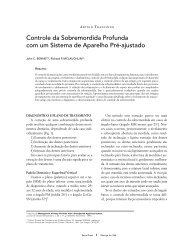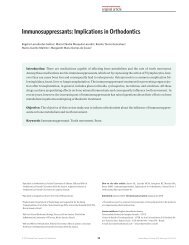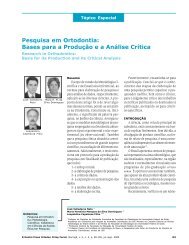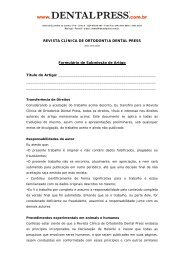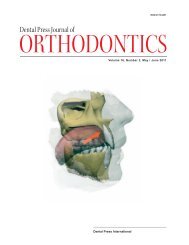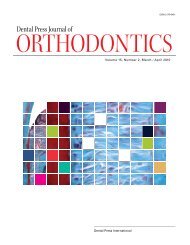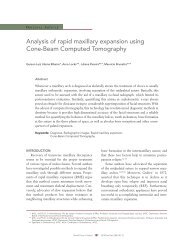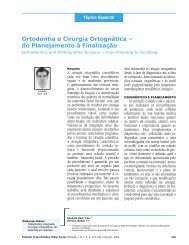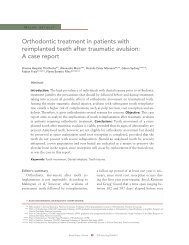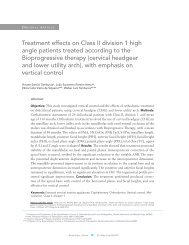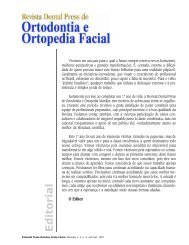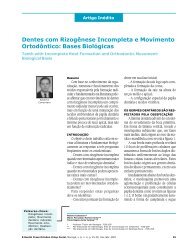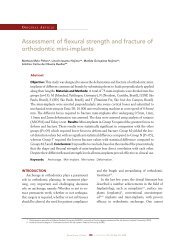Assessment of shear bond strength of brackets ... - Dental Press
Assessment of shear bond strength of brackets ... - Dental Press
Assessment of shear bond strength of brackets ... - Dental Press
You also want an ePaper? Increase the reach of your titles
YUMPU automatically turns print PDFs into web optimized ePapers that Google loves.
original article<strong>Assessment</strong> <strong>of</strong> <strong>shear</strong> <strong>bond</strong> <strong>strength</strong> <strong>of</strong> <strong>brackets</strong> <strong>bond</strong>ed by directand indirect techniques: An in vitro studyRoberto Hideo Shimizu 1 , Karlos Giovani Grando 2 , Isabela Almeida Shimizu 3 , Augusto Ricardo Andriguetto 3 ,Ana Cláudia Moreira Melo 3 , Eduardo Leão Witters 2Objective: This in vitro study was designed to evaluate the <strong>shear</strong> <strong>bond</strong> <strong>strength</strong> (SBS) <strong>of</strong> orthodontic metal <strong>brackets</strong><strong>bond</strong>ed by direct and indirect techniques.Methods: Thirty healthy human maxillary premolar teeth were used. The teeth were divided into three groups<strong>of</strong> 10 teeth each: Group I – indirect <strong>bond</strong>ing with Sondhi Rapid-Set system (3M/Unitek), Group II – indirect<strong>bond</strong>ing with Trans<strong>bond</strong> XT adhesive system (3M/Unitek) and Group III – direct <strong>bond</strong>ing with Trans<strong>bond</strong>XT adhesive system (3M/Unitek). After <strong>bond</strong>ing and obtaining the specimens for the study, the specimenswere subjected to SBS testing in a universal testing machine (Emic, model DL-500). The Kolmogorov-Smirnovtest was applied to ascertain that the data had a normal distribution and the Bartlett test to check whether therewas homogeneity <strong>of</strong> variance. One-factor analysis <strong>of</strong> variance was performed and, subsequently, Tukey’s test forpaired means. A 5% significance level was adopted.Results: The results <strong>of</strong> Group I were 67.6 (N) and 5.9 (MPa); Group II, 68.9 (N) and 6.1 (MPa) and Group III (control),92.5 (N) and 8.1 (MPa).Conclusion: It can therefore be concluded that the means for Group III were significantly higher compared withGroups I and II in both Newton (N) and Megapascal (MPa) values. The means attained by the indirect <strong>bond</strong>ing techniqueused in Groups I and II, however, exhibited no statistically significant differences.Keywords: <strong>Dental</strong> <strong>bond</strong>ing. <strong>Dental</strong> de<strong>bond</strong>ing. Shear <strong>bond</strong> <strong>strength</strong>. Corrective orthodontics.1Associate Pr<strong>of</strong>essor <strong>of</strong> Orthodontics, UTR. Pr<strong>of</strong>essor <strong>of</strong> Post-graduation course,UTP, ILAPEO and ABO.2Specialist in Orthodontics, Tuiuti University.3Pr<strong>of</strong>essor <strong>of</strong> Post-graduation course, UTP, ILAPEO and ABO.How to cite this article: Shimizu RH, Grando KG, Shimizu IA, Andriguetto AR, MeloACM, Witters EL. <strong>Assessment</strong> <strong>of</strong> <strong>shear</strong> <strong>bond</strong> <strong>strength</strong> <strong>of</strong> <strong>brackets</strong> <strong>bond</strong>ed by direct andindirect techniques: An in vitro study. <strong>Dental</strong> <strong>Press</strong> J Orthod. 2012 July-Aug;17(4):23.e1-7.Submitted: November 16, 2009 - Revised and accepted: June 20, 2011» The authors report no commercial, proprietary or financial interest in the productsor companies described in this article.Contact address: Roberto Hideo ShimizuRua Padre Anchieta, 1846 – Bigorrilho – Curitiba/PR, BrazilZip code: 80.730-000 – E-mail: robertoshimizu@yahoo.com.br© 2012 <strong>Dental</strong> <strong>Press</strong> Journal <strong>of</strong> Orthodontics 23.e1<strong>Dental</strong> <strong>Press</strong> J Orthod. 2012 July-Aug;17(4):23.e1-7
original article<strong>Assessment</strong> <strong>of</strong> <strong>shear</strong> <strong>bond</strong> <strong>strength</strong> <strong>of</strong> <strong>brackets</strong> <strong>bond</strong>ed by direct and indirect techniques: An in vitro studyintroductionOrthodontics, as a dental specialty, depends onquality adhesive systems to ensure effective orthodontictreatment. That’s why selecting a suitablebracket <strong>bond</strong>ing technique becomes vital to success.The <strong>bond</strong>ing procedure, although temporary,should be robust enough to withstand orthodonticforces and the loads resulting from occlusion. 23Currently the best clinical results are achieved bythose orthodontists who more properly place their<strong>brackets</strong>. 20 Thus, bracket <strong>bond</strong>ing to the enamelsurface <strong>of</strong> teeth is a clinical procedure that canbe performed either directly, by positioning thebracket on the tooth surface directly, or indirectly—atechnique that consists <strong>of</strong> two steps, one inthe lab and one at the clinical setting. In the firststep, the <strong>brackets</strong> are positioned on the model andtransfer trays are fabricated; in the second, the<strong>brackets</strong> are positioned on the teeth with the aid<strong>of</strong> these trays. 15The following are some <strong>of</strong> the benefits <strong>of</strong> indirect<strong>bond</strong>ing: Greater precision in <strong>bond</strong>ing the <strong>brackets</strong>;less time spent repositioning accessories, whichsaves in-<strong>of</strong>fice time; simultaneous <strong>bond</strong>ing <strong>of</strong> all<strong>brackets</strong>, which translates into reduced chair time;reduced patient discomfort and fewer <strong>bond</strong> failures.16 In contrast, this technique also suffers fromsome disadvantages, such as laboratory work time,higher cost, greater number <strong>of</strong> stages, and the interfacebetween the <strong>bond</strong>ing adhesive and the primerapplied to the tooth, which may impair adhesion.Indirect <strong>bond</strong>ing facilitates correct positioning<strong>of</strong> <strong>brackets</strong> as it provides a view <strong>of</strong> the teeth on themodel in all planes <strong>of</strong> space, providing improvedvertical positioning <strong>of</strong> <strong>brackets</strong>. It has also provenmore accurate in terms <strong>of</strong> angulation. 5 Thus, theaim <strong>of</strong> the present study was to evaluate, by means<strong>of</strong> mechanical testing, the <strong>shear</strong> <strong>bond</strong> <strong>strength</strong>(SBS) <strong>of</strong> <strong>brackets</strong> <strong>bond</strong>ed by direct and indirecttechniques.MATERIAL AND METHODSThirty human upper premolar teeth were extractedfor orthodontic purposes. These teeth exhibitedintact buccal surfaces, no cracks or fracturesfrom the extraction, and absence <strong>of</strong> caries ordemineralization.The teeth were divided into three groups <strong>of</strong> 10teeth each (n=10):» Group I: Indirect <strong>bond</strong>ing using Sondhi TM Rapid-Setsystem (3M/Unitek).» Group II: Indirect <strong>bond</strong>ing using Trans<strong>bond</strong> TMXT adhesive system (3M/Unitek).» Group III: Direct <strong>bond</strong>ing using Trans<strong>bond</strong>XT TM adhesive system (3M/Unitek).The method used in this investigation was previouslytested 15,16 by fixing the teeth by their roots in cast-stonetype IV (Durone) on a metal plate (die-casting), keepingthe crowns exposed. After taking an impression with alginate(Jeltrat) and pouring special plaster type IV (Durone),a model was obtained for indirect <strong>bond</strong>ing <strong>of</strong> Groups I andII. Group III (control) was kept in artificial saliva up to themoment that direct <strong>bond</strong>ing was performed.Clinical crown size was determined and the plastermodels marked with pencil to define the buccalaxis <strong>of</strong> the clinical crown. Gemini <strong>brackets</strong> (3M/Unitek),MBT prescription, 0.022-in slot, were <strong>bond</strong>edto the anatomical crowns using a thin layer <strong>of</strong> Trans<strong>bond</strong>TM XT (3M Unitek) light cured adhesive, takinginto account the buccal axis <strong>of</strong> the clinical crown(BACC). After removing the excess <strong>of</strong> adhesive with aprobe, each bracket was light cured for 25 seconds usinga Radii-Call- SDI LED light curing unit.After <strong>bond</strong>ing the <strong>brackets</strong> on the model, individualtrays were fabricated in a vacuum machine (VH)using a sheet <strong>of</strong> 1-mm flexible silicone vinyl overlaidwith a sheet <strong>of</strong> rigid crystal PVC with 1-mm thickness.A tray fabricated for the plaster model, was cut and dividedinto four segments with the aid <strong>of</strong> scissors anda carborundum disk, and removed from the modelalong with the <strong>brackets</strong> and the resin on their bases.After prophylaxis with pumice (SS White) mixed withwater and a Robinson brush (Microdent) at low speed(Kavo) for 10 seconds each, the teeth were washed anddried for the same time length and etched with phosphoricacid at 37% (Maquira) for 20 seconds, then washed forthe same time length. They were then dried again withsprays <strong>of</strong> oil-free compressed air for 10 seconds. A similarprocedure was performed in the three groups.A portion <strong>of</strong> the natural teeth in Group I receiveda layer <strong>of</strong> Sondhi TM Rapid-Set (3M/Unitek) resin A,while the resin on the bracket bases received a layer <strong>of</strong>Sondhi TM resin B. Thereafter, the first segment <strong>of</strong> thetray was adapted and pressed for 30 seconds onto the© 2012 <strong>Dental</strong> <strong>Press</strong> Journal <strong>of</strong> Orthodontics 23.e2<strong>Dental</strong> <strong>Press</strong> J Orthod. 2012 July-Aug;17(4):23.e1-7
Shimizu RH, Grando KG, Shimizu IA, Andriguetto AR, Melo ACM, Witters ELnatural teeth for 2 more minutes 16 according to manufacturer’sinstructions. Next, the two tray blades wereremoved with the aid <strong>of</strong> an explorer probe, while the<strong>brackets</strong> remained attached to the natural teeth, attachedto the plaster. The same procedures were performedfor each tray segment until all the teeth hadreceived some indirect <strong>bond</strong>ing resin.In Group II, a layer <strong>of</strong> Trans<strong>bond</strong> TM XT adhesivesystem primer (3M/Unitek) was applied to the teethand another layer <strong>of</strong> the same primer was applied tothe resin on the bases <strong>of</strong> the bracket in the same group.The first tray segment was adapted and each tooth waslight cured for 25 seconds (LED Radii Call - SDI). Next,the tray blades were also removed in the same manneras in Group I, until all the teeth had received indirect<strong>bond</strong>ing adhesive. Again, the <strong>brackets</strong> were light curedfor another 25 seconds each.In Group III, direct <strong>bond</strong>ing was performed usingTrans<strong>bond</strong> TM XT (3M Unitek) primer and adhesive.The teeth with <strong>brackets</strong> <strong>bond</strong>ed to them were removedfrom the plaster bases and placed on PVCpipe (Tigre) segments with 15 mm diameter and 22mm height containing self-cured acrylic resin (JET,handled according to manufacturer’s directions) assistedby a guide for standardization <strong>of</strong> test specimens(GSTS), as shown in Figure 1.Once the bracket was <strong>bond</strong>ed to the tooth, an elasticmodulus was attached to the GSTS orthodonticwire. Then, the PVC pipes were filled with colorlessacrylic resin (JET) as far as the upper edge.The samples were then subjected to SBS tests in auniversal testing machine (EMIC, model DL-500,with a speed <strong>of</strong> 0.5 mm/min with 1 kN (100 kgf ) capacity,reading resolution <strong>of</strong> 0.1 N (10 gf ), using recommendedparameters for testing within a range between 20 and1000 N. The chisel type working tip (developed for thispurpose by ODEME Company) was positioned in theocclusogingival direction in contact with the bracket,between the tie-wing and the base, close to the base (Fig2). The breaking loads were measured in Newtons (N).Data were tabulated in Newton (N) and MPa(Megapascal) in order to obtain mean values for theforce (N) and stress generated (MPa), and comparethese with the literature. The data in Newton (N) andMegapascal (MPa) were previously tested for normalityand homoscedasticity, which are the basic prerequisitesused in analysis <strong>of</strong> variance. The tests usedwere: Kolmogorov-Smirnov test to verify that thedata had a normal distribution, and the Bartlett testto check whether there was homogeneity <strong>of</strong> variance.If the data exhibited a pattern <strong>of</strong> normality andhomogeneity <strong>of</strong> variance, i.e., if they were parametric,a one-factor analysis <strong>of</strong> variance would be applied.The factor analyzed was Material, with 3 levels.Should differences occur, Tukey’s test for pairedcontrast <strong>of</strong> means would be applied. A 5% significancelevel was adopted. If one <strong>of</strong> the normalityparameters <strong>of</strong> data was violated, a nonparametricanalysis would be applied and the Kruskal-Wallistest would be applied to verify the overall differencebetween groups, as well as the Mann-Whitney testfor paired comparison. In this case, the same significancelevel <strong>of</strong> 5% was also adopted.Figure 1 - Guide for standardization <strong>of</strong> test specimens (GSTS).Figure 2 - Test system ready for <strong>shear</strong> <strong>bond</strong> test.© 2012 <strong>Dental</strong> <strong>Press</strong> Journal <strong>of</strong> Orthodontics 23.e3<strong>Dental</strong> <strong>Press</strong> J Orthod. 2012 July-Aug;17(4):23.e1-7
original article<strong>Assessment</strong> <strong>of</strong> <strong>shear</strong> <strong>bond</strong> <strong>strength</strong> <strong>of</strong> <strong>brackets</strong> <strong>bond</strong>ed by direct and indirect techniques: An in vitro studyRESULTSExploratory analysisIndividual force (N) and stress (MPa) results arepresented in Table 1 and Figures 3 and 4.Figures 3 and 4 show a graphical presentation <strong>of</strong>the same data depicted in Table 1.Table 2 shows the mean values and standard deviationsin N and MPa for each <strong>of</strong> the techniques tested.It is clear that the mean values (MPa or N) for thedirect technique used as control showed higher valuesthan the indirect techniques, either with Sondhi TMRapid-Set or Trans<strong>bond</strong> TM XT system.This increase in values for the direct techniquewas around 26 to 27% when compared with the indirecttechnique, Trans<strong>bond</strong> TM XT and Sondhi TM Rapid-Set systems. In the case <strong>of</strong> indirect techniques, thesemean values were very similar.The same data presented in Table 2 are arrangedgraphically in Figures 5 and 6.Inferential analysisGiven the fact that the mean data in N and MPashowed in Table 2 remained within a standard <strong>of</strong> normalityand homogeneity <strong>of</strong> variance, one-factor analysis<strong>of</strong> variance was applied. This analysis was statisticallysignificant (p
Shimizu RH, Grando KG, Shimizu IA, Andriguetto AR, Melo ACM, Witters ELIt is evident that for both values, i.e., Newton andMegapascal, the mean value for the control group(direct technique) was significantly higher than inthe groups where the indirect technique was used,either with the Sondhi TM Rapid-Set system or Trans<strong>bond</strong>TM XT system (p
original article<strong>Assessment</strong> <strong>of</strong> <strong>shear</strong> <strong>bond</strong> <strong>strength</strong> <strong>of</strong> <strong>brackets</strong> <strong>bond</strong>ed by direct and indirect techniques: An in vitro studyaccuracy in bracket positioning 2,14,15 as there is no interferencefrom external factors such as saliva, cheeksand tongue. Finally, guidelines can be drawn onto theteeth in the working model, providing references forthe correct placement <strong>of</strong> the orthodontic accessories.Studies conducted in the field <strong>of</strong> orthodontics havemade use <strong>of</strong> several types <strong>of</strong> mechanical tests. Amongthese are: Shear <strong>bond</strong> <strong>strength</strong> and tensile <strong>strength</strong>.Shear <strong>bond</strong> <strong>strength</strong> testing is the most widely usedbecause it simulates, to a certain extent, what happensclinically. 5 This was one <strong>of</strong> the reasons why theauthors chose to utilize this type <strong>of</strong> test.It is noteworthy that performing <strong>shear</strong> stress onsystems used for <strong>bond</strong>ing orthodontic accessoriesdepends on the parallelism between the force line <strong>of</strong>action and the <strong>bond</strong>ing surface. In the <strong>shear</strong> test, theforce is directed parallel to the long axis <strong>of</strong> the teethand as close as possible to the bracket-tooth interface. 5In order to achieve this parallelism, a bracket positionindicator was developed where the specimens couldbe consistently assembled to ensure reliable results.The technique and <strong>bond</strong>ing material used byorthodontists should promote sufficient adhesionbetween the <strong>brackets</strong> and teeth as to withstandthe application <strong>of</strong> forces during treatment. Trans<strong>bond</strong>TM XT was chosen as control in this study as ityields good clinical outcomes and is widely used byresearchers. 3,4,5,7,8,18,19,21,22 Studies were conducted inorder to evaluate the effect <strong>of</strong> self-etching, hydrophobicand hydrophilic primers. 6,7,13,17The use <strong>of</strong> Trans<strong>bond</strong> TM XT adhesive system inthis investigation proved efficient once the valuesfor <strong>shear</strong> <strong>bond</strong> <strong>strength</strong> for the control group werehigher than those advocated in the literature. 12 Thisadhesive system showed high <strong>shear</strong> <strong>bond</strong> <strong>strength</strong>when used with five different brands <strong>of</strong> metal <strong>brackets</strong>,both in terms <strong>of</strong> maximum <strong>strength</strong> (MPa) andbreaking <strong>strength</strong> values. 21In this study, a statistically significant differencewas found between the group employing direct<strong>bond</strong>ing with Trans<strong>bond</strong> TM XT (Group III,control) and the two other groups, which used indirect<strong>bond</strong>ing (Group I — Sondhi TM Rapid-Set systemand Group II — Trans<strong>bond</strong> TM XT system) inboth Newton and Megapascal values. The increasein these values observed for Group III was around26% to 27% when compared with the other groups.In comparing the results yielded by Groups I and IIonly, no statistically significant difference was found.Although the literature demonstrates efficient SBSvalues for <strong>bond</strong>ings <strong>of</strong> approximately 50 kgf (4.9MPa), SBS values <strong>of</strong> 60 to 80 kgf (5.88 to 7.84 MPa)should be obtained before bracket <strong>bond</strong>ing is consideredideal. 12 Since there were no statistical differencesbetween Groups I and II, it seems logical to assert,based on the results <strong>of</strong> this study, that there isno need for a primer especially designed for indirect<strong>bond</strong>ing since the primer provided with the conventionalTrans<strong>bond</strong> TM XT adhesive system <strong>of</strong>fered anSBS value that was similar to that observed with theSondhi TM Rapid-Set system. These data are <strong>of</strong> particularimportance for clinical orthodontists as theywill not be hard pressed to spend money unnecessarilyin order to achieve the same efficiency during theindirect <strong>bond</strong>ing <strong>of</strong> <strong>brackets</strong>.In assessing the <strong>shear</strong> <strong>bond</strong> <strong>strength</strong> <strong>of</strong> the Trans<strong>bond</strong>TM XT system in a control group using bovineteeth and direct <strong>bond</strong>ing, Sponchiado et al 18 found avalue <strong>of</strong> 9.29 MPa, while another study found a value<strong>of</strong> 13.88 Mpa. 9 These values were higher than the valuefound in this study, i.e., 8.1 MPa. When the <strong>shear</strong> <strong>bond</strong><strong>strength</strong> <strong>of</strong> Sondhi TM Rapid-Set system was tested 24hours after <strong>bond</strong>ing, using bovine teeth, much highervalues were found (14.98 and 14.99 MPa) 8,9 comparedto this study (5.9 MPa), which used human teeth. In asimilar study, higher values were found. 22 The groupusing Sondhi TM Rapid-Set system (indirect <strong>bond</strong>ing)yielded 10.9 MPa and Trans<strong>bond</strong> TM XT (direct<strong>bond</strong>ing), 11.2 MPa, showing no statistically significantdifferences between them. Thus, all values wereabove those recommended by the literature 1 (5.9 and7.8 MPa) as suitable for use in clinical orthodontics.When Trans<strong>bond</strong> TM XT was used in tensile tests usingthe direct <strong>bond</strong>ing technique, it showed a higher value(12 MPa) than the one found in this study (8.1 MPa). 19However, when indirect <strong>bond</strong>ing was employed, Trans<strong>bond</strong>TM exhibited a value <strong>of</strong> 8.49 MPa and Sondhi TMRapid-Set, 4.97 MPa, unlike the results <strong>of</strong> this research,which were 6.1 and 5.9 MPa, respectively. A value similarto this study (9.29 MPa) was found in <strong>shear</strong> <strong>bond</strong><strong>strength</strong> tests using the same material as control. 18Evidence shows that Sondhi TM Rapid-Set displayshigher SBS values in the initial phase than ConciseEnamel and Custon IQ, but after five minutes no sig-© 2012 <strong>Dental</strong> <strong>Press</strong> Journal <strong>of</strong> Orthodontics 23.e6<strong>Dental</strong> <strong>Press</strong> J Orthod. 2012 July-Aug;17(4):23.e1-7
Shimizu RH, Grando KG, Shimizu IA, Andriguetto AR, Melo ACM, Witters ELnificant differences could be found between them, 15unlike what happened in this research, in whichSondhi TM Rapid-Set presented the lowest values <strong>of</strong><strong>shear</strong> <strong>strength</strong> after 12 hours <strong>of</strong> <strong>bond</strong>ing.Apparently, both direct and indirect <strong>bond</strong>ing techniquescan be considered satisfactory and similar toeach other, 1,2,23 once <strong>shear</strong> <strong>bond</strong> <strong>strength</strong> values werefound to be above the minimum recommended by theliterature for clinical use, which validates both bracket<strong>bond</strong>ing techniques.Long-term prospective clinical studies are neededto further establish the evidence-based efficiency <strong>of</strong>such materials. Pr<strong>of</strong>essionals are advised to selecttheir orthodontic <strong>bond</strong>ing materials after a criticalanalysis <strong>of</strong> their composition, working properties andscientific foundations.CONCLUSIONSBased on the study outcomes and the statisticalmethod applied it is reasonable to conclude that:1) The means for Group III were significantlyhigher than those in Groups I and II in bothNewton (N) and Megapascal (MPa) values.2) There were no statistically significant differencesbetween the means <strong>of</strong> Groups I and II, both inNewton (N) and in Megapascal (MPa) values.3) The results found in the three groups werewithin the range <strong>of</strong> mean values found in theliterature and can therefore be safely used inclinical orthodontic practice.4) From a clinical standpoint, it is not necessaryto use a primer specially designed for indirect<strong>bond</strong>ing.ReferEncEs1. Aguirre MJ, King GJ, Waldron JM. <strong>Assessment</strong> <strong>of</strong> placement and <strong>bond</strong> strengwhen comparing direct <strong>bond</strong>ing to indirect <strong>bond</strong>ing techniques. Am J Orthod. 1982Oct;82(4):269-76.2. Battaglini RLS, Benvenga MN. Estudo comparativo entre as técnicas de colagem de“<strong>brackets</strong>” direta e indireta em ortodontia. Odontologia (USF). 1993 Jan-Dez;11(1):51-76.3. Giannini C, Francisconi PAS. Resistência à remoção de braquetes ortodônticos sob açãode diferentes cargas contínuas. R <strong>Dental</strong> <strong>Press</strong> Ortodon Ortop Facial. 2008;13(3):42-9.4. Guenthner TA, Larson BE. Indirect <strong>bond</strong>ing: a technique for precision and effiency. SeminOrthod. 2007;13:58-63.5. Ianni DF, Silva TBC, Simplicio AHM, L<strong>of</strong>fredo LCM, Ribeiro RP. Avaliação in vitro da forçade adesão de materiais de colagem em ortodontia: ensaios mecânicos de cisalhamento.R <strong>Dental</strong> <strong>Press</strong> Ortodon Ortop Facial. 2004;9(1):39-48.6. Iijima M, Ito S, Muguruma T, Saito T, Mizoguchi I. Bracket <strong>bond</strong> <strong>strength</strong> comparisonbetween new unfilled experimental self-etching primer adhesive and conventional filledadhesives. Angle Orthod. 2010 Nov;80(6):1095-9.7. Joo HJ, Lee YK, Lee DY, Kim YJ, Lim YK. Influence <strong>of</strong> orthodontic adhesives and clean-upprocedures on the stain susceptibility <strong>of</strong> enamel after de<strong>bond</strong>ing. Angle Orthod. 2011Mar;81(2):334-40.8. Klocke A, Shi J, Kahl-Nieke B, Bismayer U. Bond <strong>strength</strong> with custom base indirect<strong>bond</strong>ing techniques. Angle Orthod. 2003 Apr;73(2):176-80. Erratum in Angle Orthod.2003 Aug;73(4):485.9. Klocke A, Shi J, Kahl-Nieke B, Bismayer U. In vitro evaluation <strong>of</strong> a moisture-activeadhesive for indirect <strong>bond</strong>ing. Angle Orthod. 2003 Dec;73(6):697-701.10. Macedo A, Zanelato AT, Moresca R, Thurler RCSB. Colagem indireta em ortodontia.Ortodontia. 2008;41(2):148-53.11. Pithon MM, Oliveira MV, Ruellas ACO. Estudo comparativo da resistência aocisalhamento de braquetes metálicos colados com cimentos de ionômero de vidroreforçados com resina. Rev Saúde Com. 2006;2(1):127-34.12. Reynolds IR. A review <strong>of</strong> direct orthodontic <strong>bond</strong>ing. Br J Orthod. 1975; 2:171-8.13. Santos BM, Pithon MM, Ruellas AC, Sant’Anna EF. Shear <strong>bond</strong> <strong>strength</strong> <strong>of</strong> <strong>brackets</strong><strong>bond</strong>ed with hydrophilic and hydrophobic <strong>bond</strong> systems under contamination. AngleOrthod. 2010 Sep;80(5):963-7.14. Santos PCF, Monteiro ALV, Freitas BV, Irikita KLM, Santiago KM. Técnica da colagemindireta ortodôntica passo-a-passo. Orthod sci pract. 2008;1(2):200-17.15. Sondhi A. Effective and efficient indirect <strong>bond</strong>ing: The Sondhi method. Semin Orthod.2007;13: 43-57.16. Sondhi A. Efficient and indirect <strong>bond</strong>ing. Am J Orthod Dent<strong>of</strong>acial Orthop.1999;115(4):352-9.17. Soo PP, Green BM, Sondhi A. Effects <strong>of</strong> oxygen inhibition in indirect <strong>bond</strong>ing with ahydrophilic adhesive. Am J Orthod Dent<strong>of</strong>acial Orthop. 2009 Feb;135(2):214-21.18. Sponchiado AR, Wunderlich AE, Galleta OS, Rosa M. Avaliação do uso do Self AtchingPrimer na ‘colagem de braquetes ortodônticos metálicos. R <strong>Dental</strong> <strong>Press</strong> Ortodon OrtopFacial. 2005;3(3):22-9.19. Tortamano A, Nauff F, Naccarato SRF. Avaliação da força de tração em braquetes coladospela técnica indireta com diferentes sistemas de adesão. R <strong>Dental</strong> <strong>Press</strong> Ortodon OrtopFacial. 2007;12(3):104-10.20. Trevisi HJ, Zanelato RC, Zanelato ACT. Colagem indireta na técnica MBT. Rev ClínOrtodon <strong>Dental</strong> <strong>Press</strong>. 2002;1(2):47-59.21. Vasques WO, Ciruffo PSD, Tirbell CAM, Miyamura ZY, Vedovello MF. Resistênciaao cisalhamento de diferentes braquetes metálicos colados com resina compostafotoativada (Trans<strong>bond</strong>). Estudo comparativo in vitro. RGO Rev Gaucha Odont.2005;53(3):186-90.22. Yi GK, Dunn WJ, Taloumis LJ. Shear <strong>bond</strong> <strong>strength</strong> comparison between directand indirect <strong>bond</strong>ed orthodontic <strong>brackets</strong>. Am J Orthod Dent<strong>of</strong>acial Orthop. 2003Nov;124(5):577-81.23. Zachrisson BU, Brobakken BO. Clinical comparison <strong>of</strong> direct <strong>bond</strong>ing versus indirect<strong>bond</strong>ing with a different bracket type and adhesives. Am J Orthod. 1978 Jul;74(1):62-78.© 2012 <strong>Dental</strong> <strong>Press</strong> Journal <strong>of</strong> Orthodontics 23.e7<strong>Dental</strong> <strong>Press</strong> J Orthod. 2012 July-Aug;17(4):23.e1-7



